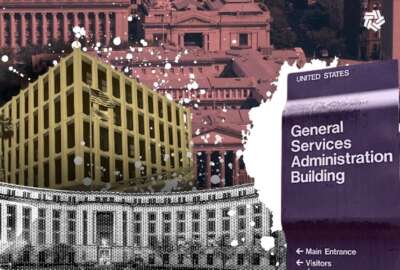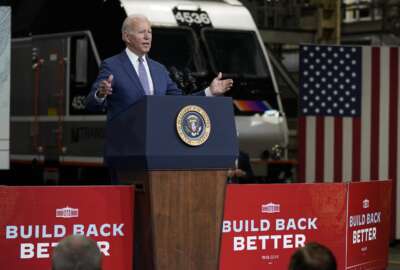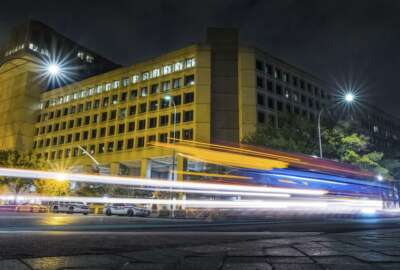

The Biden administration expects upcoming sustainability standards for federal buildings will put agencies on a realistic path to meeting some of President Joe ...
The Biden administration expects upcoming sustainability standards for federal buildings will put agencies on the path to meeting some of President Joe Biden’s green government goals.
Federal Chief Sustainability Officer Andrew Mayock said last week that the administration’s Federal Sustainability Plan will put the federal government “back in a position where we’re leading by example” on climate goals for the private sector to emulate.
“The government basically sat out sustainability for four years, and at best, things stayed in place, and at worst, we went backward. So we’re in a rebuilding phase and a learning phase,” Mayock said on June 28 at the Federal Sustainability Forum, hosted by the Business Council for Sustainable Energy and the Digital Climate Alliance.
President Biden, as part of an executive order he signed last year, expects agencies to reach net-zero greenhouse gas emissions across all federal operations by 2050. That includes a 65% reduction by 2030.
“We’re not getting where we need to go, unless we focus on how we scale. And how we scale is through technology,” Mayock said.
Melanie Nakagawa, special assistant to the president and senior director for climate and energy at the National Security Council, said the leadership of at least 20 agencies is committed to implementing the administration’s clean-energy goals across the federal government.
“It’s really hard to find a department or agency that isn’t willing to take the call or engage,” Nakagawa said.
While agencies with the biggest climate impact are moving ahead on the administration’s sustainability goals, Mayock said the Federal Sustainability Plan focuses on making green initiatives a top priority governmentwide.
“We need to start acting and delivering as an enterprise, versus the deeply federated federal government that we are today. There are lots of efficiencies and lots of actions that we can take when we work better and more closely together,” he said.
The White House Council on Environmental Quality in May launched an interagency task force with the General Services Administration, the Energy Department and the Environmental Protection Agency to develop the first-ever Federal Building Performance Standards.
The standards will establish metrics, targets and tracking methods to reach federal carbon emissions goals. Mayock said the standards, which he said will be publicly released in two or three months, will set standard performance goals across more than 300,000 federal buildings.
“The ways that we’ve executed this sustainability plan and past versions of it over past administrations, that didn’t speak to the decarbonization moment that we’re in today,” Mayock said.
While the administration is making government more sustainable where possible, several administration officials said some federal climate goals will rely more on cooperation with the private sector.
Mayock said emerging sustainability technologies, for example, will be crucial to meeting some of the federal government’s climate goals.
“A lot of the technology, but not all of the technology, is where we want to be. How do we handle that moment in the marketplace to make progress now, while we’re all pushing for the technology that we need to be delivered along the pathway?” Mayock said.
Tanuj Deora, CEQ’s director for clean energy, said the administration is trying to use its collective buying power to support sustainable energy industries but is also trying to overcome supply constraints in the market for goods like electric vehicles.
“We don’t want to be consumptive of the market’s ability to supply. We don’t want to crowd out other folks who are trying to invest. I know with electric vehicles right now, one of the biggest challenges GSA has is that the vehicles just aren’t available,” Deora said.
Deora said a pandemic-era shortage of semiconductor chips has limited the supply of all vehicles, including electric vehicles, for federal agencies to purchase.
White House National Climate Advisor Gina McCarthy, a former EPA administrator under the Obama administration, said last year that less than 1% of the federal fleet is plug-in electric vehicles, and that agencies bought only 200 electric vehicles in 2020.
Kinga Hydras, a sustainable program design expert with GSA’s Office of Federal High-Performance Green Buildings, said electrifying the federal fleet also impacts plans to improve the energy efficiency of federal buildings.
“It’s not just buying the vehicles, it’s also creating the infrastructure and doing it in a smart way. Now that it all plugs into our federal building portfolio, then how does that impact our energy consumption? How do we go about partnering with the utilities in the servicing markets, and maybe utilize the electric vehicle fleet as backup power. A lot of questions, a lot of opportunities out there,” Hydras said.
Hydras said GSA’s federal building portfolio within the Washington, D.C. metro area has reduced energy consumption by 60% through integrated energy retrofit projects.
GSA manages a portfolio of 370 million rentable square feet of space for more than a million federal employees. Its Federal Acquisition Service, meanwhile, oversees about $75 billion worth of annual contracts.
“We are all in it together. As most federal agencies and large organizations have silos, we do have silos too, but this aggressive goal brought us all together,” Hydras said.
The Energy Department, meanwhile, partnering with GSA to spend $13 million to retrofit and upgrade 17 federal facilities to reduce emissions and energy costs.
“We believe technology is way ahead. We see in the marketplace the technology’s there. We need to be smart about implementing and using everything in our tool house,” Hydras said.
Hydras pointed to the New Carrollton Federal Building as an example of a successful retrofit project. The building went through upgrades between 2012 to 201, which reduced the building’s energy consumption by 62% and cut water consumption in half.
Deora said federal agencies can better leverage data to find more buildings that stand to benefit the most from these sustainable upgrades, much like the New Carrollton Federal Building.
“It’s just a great example. There was one great value case, how can we take that and then replicate that and make that system-wide? We need to think about the value stack from not just energy or storage or whatever, but from the data itself,” Deora said.
The Biden administration is also looking to accelerate the pace of federal permitting and environmental reviews for thousands of infrastructure projects under the $1 trillion Bipartisan Infrastructure Law.
The White House in May released a permitting action plan outlining ways agencies can ensure infrastructure spending projects remain on time and on budget.
However, Cole Simons, a policy adviser for Sen. Bill Cassidy (R-La.) said that more federal permitting reforms to are needed to prevent wasteful infrastructure spending.
“We need to eliminate some of the duplicity that is in the process. We’ve got issues right now, where Army Corps [of Engineers] says yes. Six months later, the EPA drops in and says ‘Just kidding, no,’ and there’s already been steel put in the ground, or there’s already been a process started, that just creates more waste, both from having already started a process and having to end it and you’re just like, ‘Well, what do we do with stuff that’s already there?’ as well as a lot of financial waste and a lot of uncertainty provided to anybody who seeks to develop in the U.S,” Simons said.
Copyright © 2024 Federal News Network. All rights reserved. This website is not intended for users located within the European Economic Area.
Jory Heckman is a reporter at Federal News Network covering U.S. Postal Service, IRS, big data and technology issues.
Follow @jheckmanWFED



